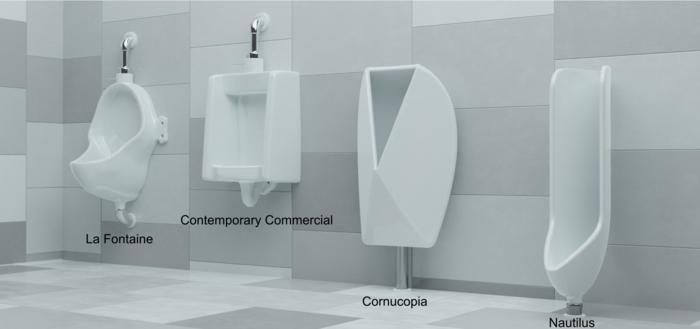Innovative Urinal Designs: A Splash-Free Future for Public Restrooms
The humble urinal, a fixture often relegated to the background of public bathrooms, has undergone little change since its inception over a century ago. Despite being celebrated as a piece of art by Marcel Duchamp in his groundbreaking 1917 work, "La Fontaine," the traditional design of urinals presents significant challenges in hygiene and user experience. A new wave of research, however, promises to transform urinals into models of sanitation and accessibility.
A significant concern with conventional urinals is the issue of splashback. The design typically leads to urine splattering onto the floor and, in unfortunate cases, onto the user, which creates a messy situation that not only raises cleanliness concerns but also poses a risk for disease transmission. Recent studies have highlighted the need for improved designs that can mitigate splashback while enhancing the overall experience of using public restrooms.
Researchers Zhao Pan, Kaveeshan Thurairajah, and their team have tackled the problem of splashback through a combination of physics and innovative design principles. By examining the flow of urine and its interaction with surfaces at varying angles, they established that maintaining an impinging angle of 30 degrees or less significantly reduces the chances of splashback. This fundamental insight led them to pursue the development of new urinal designs—aptly named Cornucopia and Nautilus.
The Cornucopia and Nautilus models are not merely theoretical constructs; they are actual designs conceived through a detailed analysis and solving of differential equations. By utilizing precise calculations, the researchers succeeded in creating urinals that optimally channel and direct urine flow, ensuring a cleaner experience for users. The introduction of these new models could mark the end of the classic splash problem that plagues public restrooms globally.
One noteworthy feature of the Nautilus design is its versatile structure, which accommodates various users, including children and individuals using wheelchairs. This inclusive approach signifies a broader aim of the researchers: enhancing accessibility in public facilities. By ensuring that all individuals can use the restroom facilities comfortably, the Nautilus urinal aligns with modern values of inclusivity and equality.
Calculating the potential impact of these new designs, the authors of the study estimated that replacing every traditional urinal in the United States—around 56 million units—with the Nautilus model could prevent an astounding one million liters of urine from splashing onto public restroom floors each day. Such a dramatic reduction in waste not only contributes to sanitation efforts but also supports broader environmental sustainability goals.
Beyond hygiene and accessibility, the researchers recognize that a well-designed urinal can help to reshape societal attitudes towards public restroom facilities. Facilities that prioritize cleanliness and user comfort are likely to encourage more individuals to utilize them, which is of particular importance in urban settings where public restrooms can often be few and far between. By advocating for enhanced urinal designs, authorities can show a commitment to public health and well-being.
The implications of these findings extend beyond microbiology and user preferences; they intersect significantly with the disciplines of mathematics and engineering. The incorporation of differential equations in the design process exemplifies a fascinating crossover between science and daily life, providing a practical application of complex mathematical principles. This synergy between disciplines highlights the ongoing need for innovative thinking and research in addressing everyday problems.
Moreover, the call for designers and engineers to engage with the arts and humanities cannot be understated. The narrative surrounding the functionality of urinals has evolved to reflect larger themes of aesthetics, societal norms, and public health. As the work of Duchamp illustrated, even the most banal objects can evoke deep philosophical discussions about art, utility, and their place in our lives.
As this research gains visibility, it raises questions about the future direction of public restroom facilities. Will we see an overhaul of traditional designs in favor of scientifically derived models? Could there be a shift in how we perceive sanitation and user experience in public spaces? The answers to these questions lie in continued innovation, research, and perhaps, a greater willingness to embrace change.
In conclusion, the exploration of urinal design through scientific inquiry presents a prime example of how problem-solving can yield creative solutions that benefit society at large. By focusing on the intersection of physics, accessibility, and public health, the designs of Cornucopia and Nautilus pave the way toward a cleaner and more inclusive future. As we work toward sustainability in all facets of life, it’s essential to remember that even the simplest of innovations—like a splash-free urinal—can have profound impacts.
This research not only potentially revolutionizes a long-overlooked aspect of public health but serves as a reminder of the importance of continuous evaluation and redesign of everyday objects to meet the evolving needs of society. Ultimately, for generations to come, these new designs could transform the way public restrooms are perceived and utilized, one splash-free urinal at a time.
Subject of Research: Urinal Design Improvements
Article Title: Splash-free urinals for global sustainability and accessibility: Design through physics and differential equations
News Publication Date: 8-Apr-2025
Web References: N/A
References: N/A
Image Credits: Thurairajah et al
Keywords: Urine, Disease prevention, Differential equations.




